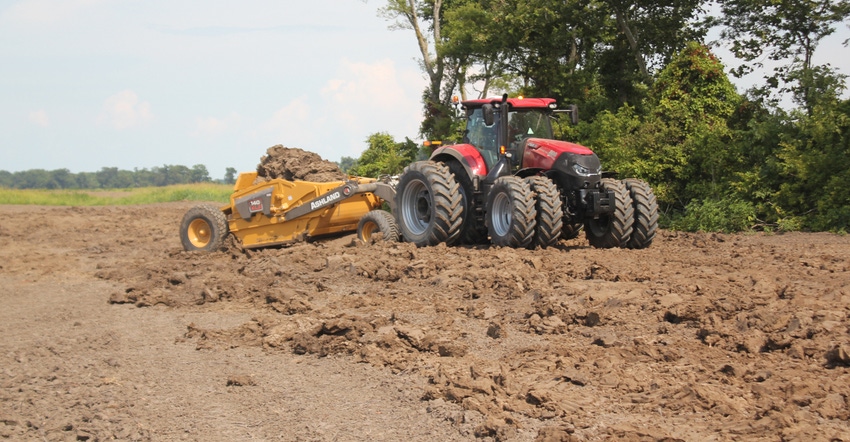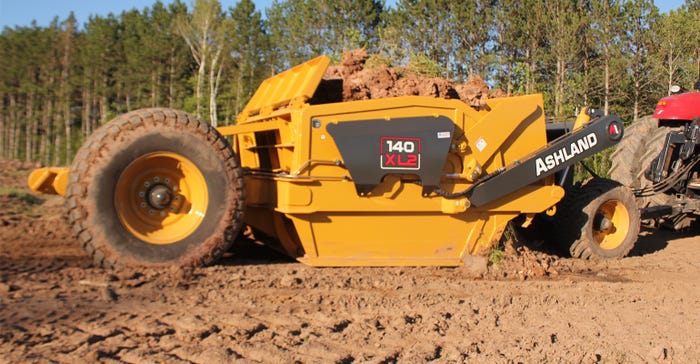
Excavating contractors have been using scrapers for decades. Farmers have been using precision mapping and guidance tools for almost as long. But combining earthmoving equipment with precision grade control is relatively new, with most of the modern technology emerging within the last five years.
Dave Benson, regional sales and market development manager for Ashland Industries, a manufacturer of scrapers, says the technology is coming into use at a good time, just as thousands of farmers are faced with the need to remediate their fields from a season of record flooding across the middle of the country.
“The extent of the damage that’s out there is almost impossible to grasp,” Benson says. “But there is technology to help.”
Ashland scrapers pick up soil from the desired part of the field and deposit it evenly where fill is required, he says. And paired with GPS-based Trimble precision grade control from Modern Ag Inc., it is possible for a single operator to contour the land precisely as it needs to be.
“The precision grade control I use is made by Trimble, the same company that makes guidance systems for tractors and sprayers and combines,” says Darren Kleitz, a farmer who is also a general dirt work and excavating contractor in northeast Kansas. “I worked with Gabe Gantz at Modern Ag Inc. to have it installed on our scraper. It builds a map that tells you if you are too high or too low.
"It just gets rid of all the guesswork. I don’t have to have a grade checker down on the ground or anybody running around with a rod and laser. It basically turned a three-man operation into a one-man operation.”
Precision technology in demand
Gantz says Modern Ag is expecting a sharp increase in demand for the grade control technology because of the widespread damage from flooding and the need to modernize drainage systems in areas that suffer from low production due to drainage issues.
The system works well on a number of earth-moving machinery, Gantz says.
“In the eastern part of the state, people use it for building terraces and waterways,” he says. “In the western part of the state, people are using it to do surface contouring and eliminate low spots in the field that cause mudholes.
"We had one customer out by Garden City who had a problem with a low spot in a circle. Using the grade control system, he was able to bring soil from the corners and fill in that spot to get the water to drain properly. The idea is to be able to make the ground we have more productive instead of having to buy more land or put more land in production.”
 FLOODING CREATES DEMAND: Precision grade control is available for Ashland scrapers, just in time to help the thousands of farmers affected by flooding remediate the damage to fields.
FLOODING CREATES DEMAND: Precision grade control is available for Ashland scrapers, just in time to help the thousands of farmers affected by flooding remediate the damage to fields.

Gantz says he has seen a sharp increase in the number of producers looking for a tool that helps them achieve flood remediation and get their land properly contoured for the best drainage.
A flood of issues
Kleitz says his only problem with his “smart” scraper in 2019 was that the weather remained too wet for him to use it.
“We haven’t had more than seven days in a row without rain since October of 2018,” he says. “We couldn’t get crops harvested last fall, then we couldn’t get them planted in the spring. We couldn’t get hay put up, and Pottawatomie Creek and the Marias des Cygnes River have both been in flood three or four times this summer. I lost 300 to 400 acres of beans to flooding after it was too late to replant. It’s just been a mess.”
One of the biggest problems, he says, is rains that come hard and fast at the rate of 3.5 to 4 inches per hour.
“It washed the roads out and put a two-foot ditch across the middle of the road,” he says. “The road ditches fill up with debris and dirt that washes off the fields, then the water washes the gravel off the roads and puts it in the ditch or across the road on another field. Once this settles down, there’s going to be a lot of demand for dirt work.”
Kleitz says he likes the Ashland scraper because it acts like a self-loading and unloading dump truck. He says he also likes the super-wide flotation tires that reduce compaction.
“The receiver for the grade control is on the part that goes up and down,” he says. “GPS knows exactly where you are for elevation and the newer ones will automatically adjust the elevation. You can just watch the screen and tell if you are too deep or too shallow. You can set the grade for 0% or 1% to make it perfect.”
He says the system also eliminates the need to call a Natural Resources Conservation Service agent to lay out a terrace.
“We can just raise the scraper and drive all over the field, dropping flags every 10 feet or so," he says. "Then we go to the computer and it tells us the more efficient place to put the terrace and lays it out for us. I can go out with the 4-wheeler, survey and look at the map to draw a line and start building. It makes it a lot more efficient and less costly for the people that I am working for.”
Gantz says operators are also finding out that adding the precision grade control system improves their quality of life.
“You aren’t constantly getting out of the tractor to move a tripod and laser around,” he says. “You can get in the cab and not have to get out until lunch.”
Kleitz says the GPS system can also be used on a tile plow.
“I have a neighbor who has a tile plow to put in tile system and it runs on the same GPS system the scraper does,” he says. “Between the two of us, we can handle just about anything for drainage. I just hope we get a winter that lets us get the work done.”
Read more about:
FloodingAbout the Author(s)
You May Also Like






